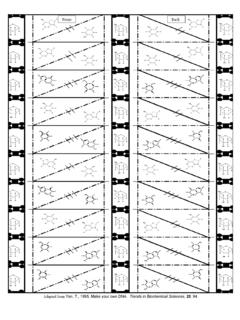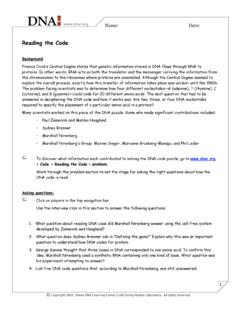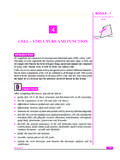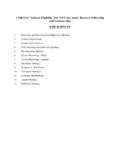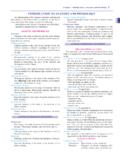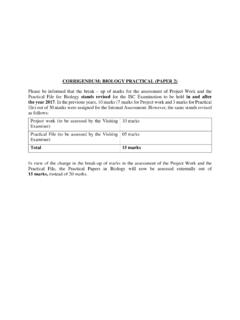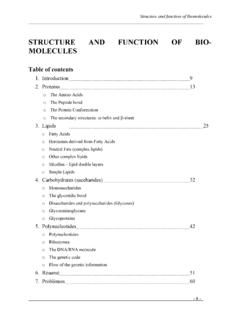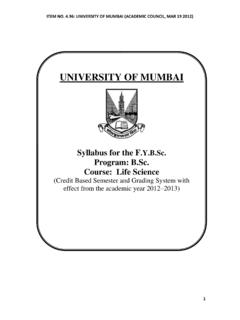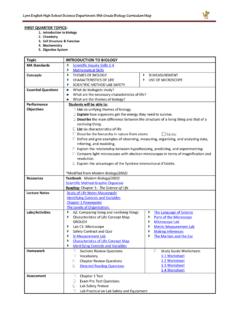Transcription of Finding the Structure: pieces of the puzzle - DNA
1 Finding the Structure: pieces of the puzzleDescription of activityFinding the structure provides students with theopportunity to view short video clips of the severalscientists involved in the discovery of the structureof DNA. Students are asked to decide if theinformation on pieces of the DNA puzzle is accurateand correctly correlated with the scientist OutcomesStudents will:1. listen to and collect information related byscientists in video understand that scientists work together to appreciate the contribution each scientist made toour understanding of work together to evaluate data in order to solvetheir version of the DNA of Prior KnowledgeScience experiences in the middle school should haveprovided students with some knowledge of heredity,the transmission of traits, and often think that different cells havedifferent kinds of DNA.
2 This is how they explainvariations in structure and function from one type ofcell, tissue, and organ to another. Holding this beliefwould make understanding the significance ofChargaff s ratio the LessonBecome familiar with the DNA Interactive (DNAi)web site ( ) and how to navigate throughit. Provide students with information about navigatingthe site, and how to play animations and video class:Photocopy the two sets of puzzle pieces . Cut out thepieces and place a set of both correct and incorrectpieces in an envelope. Enough sets should be made sothat students can work in teams of two. Hint: Usecardstock or laminate the copies so that the puzzlepieces can be used with multiple class:Discuss with students what they know about howgenetic information is transmitted from onegeneration to the next.
3 Ask them why scientists wouldbe interested in knowing more about this topic andwhy they as students are each team of students with copies of theactivity Finding the structure and envelopes of , have students follow their worksheets to accessthe DNAi class:Address possible misconceptions (one is listed atleft). An appropriate misconception question could be: Students often think that different cells havedifferent DNA. Explain why this statement isincorrect. 1 Further ExplorationsWritingTell students that they are reporters for the NewYork Times Science section. They have been assignedto write a series of one-page articles informingreaders about why DNA has been heralded as themost important molecule ever discovered.
4 The firstpiece should explain the basic structure of the DNAmolecule. These articles should be written for thegeneral BuildingCreate DNA models from common household model must be at least 20 nucleotides long andform two turns of the helix. Remember that thereare 10 bases per turn. Include a key to show how thephosphates, sugars and nitrogen bases arerepresented. Remember to include the correct numberof hydrogen bonds between the students make concept maps about the structureof DNA using the following terms:DeoxyribosesugarPhosphategroupsThy mineAdenineCytosineGuanineNucleotidesDou ble helixNitrogen basesThey should add other words that are necessary tomake their map accurate. Be sure that they includethe proper linking words between the concepts andthink up an appropriate title for their (deoxyribonucleic acid)HelixAdenine, Guanine, Cytosine, and Thymine (A, G, C, & T)NucleotidePhosphate groupIonizedResourcesWebAccess Excellence @The National Health Museum(1994-2003).
5 Ae@nhm: the Site for Health &Bioscience Teachers and Learners, Spring Harbor Laboratory (2002). DNA From theBeginning: an animated primer on the basics of DNA,genes, and heredity, Wilson National Fellowship Foundation(2002). Leadership Program for Teachers: TeacherResources > Core Websites, for the Double Helix. Available from CarolinaBiological Supply Company, Interactive (2003).! NTSC version produced byCold Spring Harbor Laboratory and Red Green & BlueCompany; funded by Howard Hughes MedicalInstitute.! Available at , James D. (1968). The Double Helix, W. & Company, New , J. D., and Crick, (1953). Molecular structure of Nucleic Acids: AStructure of Deoxyriboose Nucleic Acid, Nature 171, , A.
6 (1968). Rosalind Franklin and theDiscovery of the structure of DNA, Nature219, , L., and Corey, R. B. (1953). A ProposedStructure for the Nucleic Acids, Proc. Sci. 39, pages include:Student sheets with listings of scientists andboth correct and incorrect correlations fromthe puzzle puzzle template with correct correlations andDNA background puzzle template with incorrect correlationsand an incorrect DNA background image (withblank pieces for additional incorrect clues).3


